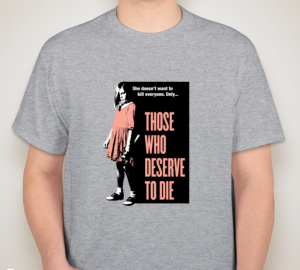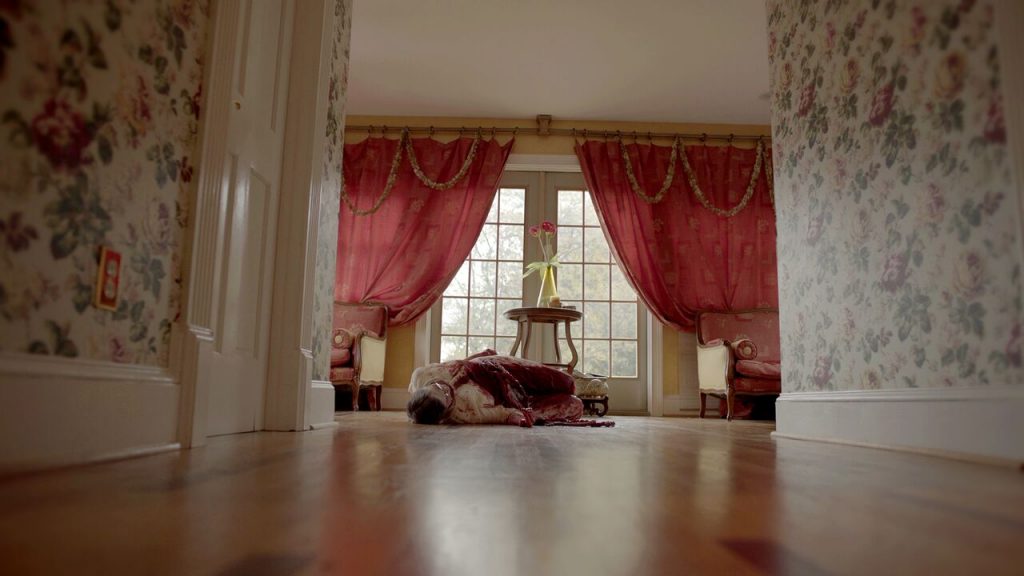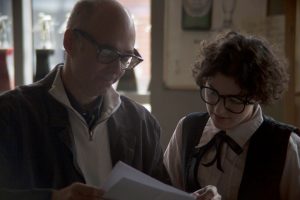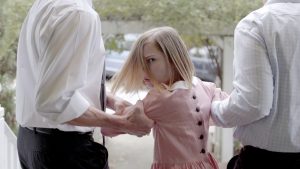by Melanie Crew
Managing Editor
The last time we caught up with the ever-busy Atlanta filmmaker Bret Wood was before the 2014 Atlanta Film Festival screening of THE UNWANTED, his contemporary take on Sheridan Le Fanu’s vampire novella “Carmilla.” Bret is at it again with his current independent cinematic endeavor, THOSE WHO DESERVE TO DIE (TWD2D), a loose modern-day adaptation of Thomas de Quincey’s novella “The Avenger.” Fueled by visions of ‘60s gialli.” TWD2D is a thriller that “subverts the formula of the revenge film,” following its “hero” as he seeks gruesome justice. According to its official description: “Goaded by the cold-hearted spirit of his undead 10-year-old sister Berenice, Jonathan wades into ever-deepening, ethically muddier water—for their plan is to not just punish the guilty, but extinguish their bloodlines entirely.” The film stars Joe Sykes [V/H/S (2012); THE LITTLE DEATH (2010)], Alice Lewis (first starring role) and Rachel Frawley. While Bret has personally funded all of his prior film projects, this ghastly twist of a revenge story is being partially funded by a Kickstarter campaign chock full of enticing perks, including copies of the film upon its release to video (Fall 2018). Be a part of bloody fantastic film history and snatch up a killer perk or two via the crowd-sourcing campaign available through February 25! Check out the full range of rewards here!
A rare and obscure film connoisseur, Bret regularly digs deep into the historic cinematic landscape through his enviable day-job as Vice President of Special Projects with Kino Lorber. On the heels of receiving the 2016 Film Heritage Award from the National Society of Film Critics for his PIONEERS OF AFRICAN-AMERICAN CINEMA (2016) collection, he dove right into his next restoration project, PIONEERS: FIRST WOMEN FILMMAKERS, promising to expose viewers to lesser known, yet significant female film pioneers.
 ATLRetro caught up with Bret for a quick rundown on THOSE WHO DESERVE TO DIE, his devotion to film history’s weirdest and wackiest; and why going with crowd-funding made sense for this project! While you’re takin’ a gander at our little Q&A, why not take a sinister peek at the teaser trailer for TWD2D here.
ATLRetro caught up with Bret for a quick rundown on THOSE WHO DESERVE TO DIE, his devotion to film history’s weirdest and wackiest; and why going with crowd-funding made sense for this project! While you’re takin’ a gander at our little Q&A, why not take a sinister peek at the teaser trailer for TWD2D here.
ATLRetro: The last time ATLRETRO caught up with you was with your take on “Carmilla,” THE UNWANTED (2014). And now we see you’re diving head first into Thomas de Quincey’s novella “The Avenger” with your newest film adventure, THOSE WHO DESERVE TO DIE. Why “The Avenger” and why adaptations of classic literature?
Bret Wood: I’m a voracious reader, and I usually follow some thread of ideas from one book to another rather than just randomly choosing books from a shelf. It’s a great way of discovering writers I wasn’t previously familiar with. At the time I discovered “The Avenger,” I had been reading a lot of Gothic novels — specifically pseudo-memoirs from a skewed perspective — things like de Quincey’s CONFESSIONS OF AN ENGLISH OPIUM EATER, Charles Maturin’s MELMOTH THE WANDERER and James Hogg’s THE PRIVATE MEMOIRS AND CONFESSIONS OF A JUSTIFIED SINNER. I think it was Joris-Karl Huysmans’s THE DAMNED (LA-BAS) that started me on this whole journey. I like this era of literature because it’s the kind of thing not many other people are reading, and it’s all in the public domain, so if I do find a story that would work well as a film, it’s mine for the taking. There’s nothing worse than discovering a story that would make an incredible film, but knowing it would be impossible to clear the rights (there’s a William Lindsay Gresham [NIGHTMARE ALLEY] story I’m dying to adapt.)
And with pre-1900 books like these, I’m really adapting the spirit of the work, not the plot. As THE UNWANTED bears little physical resemblance to “Carmilla,” THOSE WHO DESERVE TO DIE does not replicate the plot of “The Avenger.” But hopefully both of them capture the emotional essence of what makes both of those stories so compelling, and so troubling.
Why a Kickstarter for THOSE WHO DESERVE TO DIE? What are the advantages of taking the crowd-sourcing route?
Previously I’ve self-funded all my films, but the cost of indie filmmaking in Atlanta has risen considerably since the arrival of Hollywood productions. It’s become more difficult to secure locations, and we have to compete with major studio productions for crew. Just a few years ago, when filmmaking opportunities were limited, there was an abundance of crew who were eager to take on labors of love in order to get experience and make the kind of connections they could build careers on. Now, everyone’s busy on well-paying projects, and it’s not fair for us to ask them to show up on their days off and work 10 to 12-hour days for the love of the art. Over the course of making TWD2D, we’ve assembled a terrific, very dedicated core crew, but I want to treat them fairly and not burn them out on independent production. We want to leave them willing to support the next grassroots project – to insure that this kind of filmmaking can continue in Atlanta.
There are several great things about crowd-funding. One is that it allows anyone to participate. And the size of the donation is less important than the knowledge that someone out there likes the idea of what you’re doing and wants you to see it through to completion. Another attribute of Kickstarter is that when people make a contribution, there are no strings attached. They are supporting the creation of your work without imposing conditions or restrictions upon the donation. As soon as artists accept money from an investor, they can’t help but begin to think of the film as a business and bear the responsibility of shaping the film into something that will become profitable. You can’t help it. That Hollywood mentality starts to creep in.
I’m not saying my vision is “pure” or that profitable films are somehow corrupt. But I am trying to make films from the gut – that evolve and find their own form through the process of collaborating with other artists. THOSE WHO DESERVE TO DIE is a film that emerges from the process of making a film. Just last week, two of the actors (Joe Sykes and Keith Brooks) helped me re-conceptualize a scene that was problematic, and we shot that sequence over the weekend. Likewise, we try to make sure the set is a place where new ideas are welcome, and we’re not just banging a punch list of predetermined shots.
You’ve put together some great bonuses for investors, ranging from special DVDs and Blu-rays to pass codes to stream your past films to posters and private screenings (Exciting!). What can folks looking to invest via Kickstarter expect to get when they back your film?
I think most people want to get a copy of the finished film, but for those who don’t want to wait the year-and-a-half it will probably take for TWD2D to be completed and then released on video, they can join us for the cast-and-crew screening, get copies of my previous work, two different styles of T-shirt, and I’ve dragged out a few things from my memorabilia closet, including a key prop from THE UNWANTED [Millarca’s severed head] and an original print by David Lynch for any big-money donors out there. Of course the greatest reward of all is the satisfaction of keeping truly independent film alive and well in Atlanta – and you get that even at the $5 pledge level.
Looks like many of your cast and crew are Atlantans or from the surrounding area, including yourself. What can you tell us about your cast/crew and why do you think it’s important to work with local talent?
With Atlanta being overwhelmed with studio production, I think it’s more important than ever that indie film projects ORIGINATE locally. The studios have come here for the tax breaks but quickly discovered what a rich and deep pool of filmmaking talent resides here. I don’t think anyone expected the Georgia film industry to expand the way it has — and you can’t chalk that all up to tax incentives. The problem is that the writers/directors/leading actors of these projects are still almost exclusively brought in from the West Coast. The studios and networks don’t see this as a place where ideas are originated and projects germinated. The most successful content-originators in Atlanta are self-starters — people like Will Packer and Tyler Perry. And we need more filmmakers like that — who are crafting their own unique work, and not asking some corporate entity for permission to make films.
You’re a well-known local film historian, as Vice President of Special Projects with Kino Lorber, and have produced Blu-ray releases for the films of legendary directors Mario Bava, Stanley Kubrick, Jess Franco, D.W. Griffith and more! Which project was the most intriguing? In the grand scheme of things, why do you feel it is important to not only preserve film, but to share these works of art with the masses?
Just as I read books from another era, I’ve always loved watching films from the past. Part of it is my distaste for all things contemporary, but mostly it is the thrill of discovering something new. If you love cinema, then there is a whole universe out there waiting to be explored. And you can’t do it from the convenient portal of Netflix. You’ve got to get up off the couch and look for it yourself. And it’s exciting to go on a quest to track down obscure works by obscure filmmakers that only YOU truly understand and appreciate (or so it seems, until you discover there are others who share your passion for the odd and eclectic). And that process opens up social opportunities and enables you to create new friendships (both real and virtual). Go over to Videodrome and strike up a conversation with whoever’s on duty — you’ll see what I mean. That’s really a snapshot of who I am and how I defined myself during my youth.
I try to hold on to that sense of discovery in my day job, as I ferret out lesser-known films and give them the best possible presentation so that they’ll be out there for other cineastes to discover. I produce DVDs/Blu-rays of the classics, but I’m also allowed to slip into the release schedule some truly strange and fascinating films that aren’t on most people’s cultural radar; things like the silent-era drug film THE DEVIL’S NEEDLE, the satanic soft-core film THE LAST STEP DOWN, the 3-D film A*P*E, the oddball noir THE CHASE. I’ve got a full plate for 2017 and look forward to introducing some strange new flavors to people’s cinematic palate.
On the heels of receiving the 2016 Film Heritage Award from the National Society of Film Critics for your PIONEERS OF AFRICAN-AMERICAN CINEMA (2016) collection, you’ve jumped right into PIONEERS: FIRST WOMEN FILMMAKERS. Can you tell our readers a little about this project?
PIONEERS OF AFRICAN-AMERICAN CINEMA succeeded beyond our expectations, and I really felt as though I had helped consolidate and publish a hugely important chapter of American film history. It was unique in that it wasn’t just a “greatest hits” of early black cinema; it explored both the cornerstones of the movement and the virtually unknown work. We included lesser-known films. We included incomplete films. We included films so eroded by nitrate decomposition that they are almost incomprehensible. But these films are important nonetheless. They are the mortar that fills in the cracks of the bricks of black film history. And they would never be released under ordinary economic circumstances. PIONEERS was funded by a Kickstarter campaign and the $50,000+ that we raised afforded me an unprecedented amount of creative freedom — resulting in a collection of films that would otherwise have been impossible, or at least commercially unviable.
Fortunately, I was able to maintain the momentum, launch a second KS campaign, and am now knee-deep in  producing PIONEERS: FIRST WOMEN FILMMAKERS, which focuses specifically on women directors of the American film industry in the silent era. Our aim is specific because, as with the first PIONEERS, we didn’t want to make this a “greatest hits” collection [Lois Weber, Alice Guy-Blaché]. We want to show you the works you’ve never seen, and expose you to the filmmakers you’ve never heard of [Gene Gauntier, Angela Murray Gibson, Julia Crawford Ivers, Ida May Park, Marion E. Wong]. And by focusing on American silents, we’re able to tell a fascinating – and ultimately depressing – story of how women were pushed out of the director’s chair and into support roles within the Hollywood studio system.
producing PIONEERS: FIRST WOMEN FILMMAKERS, which focuses specifically on women directors of the American film industry in the silent era. Our aim is specific because, as with the first PIONEERS, we didn’t want to make this a “greatest hits” collection [Lois Weber, Alice Guy-Blaché]. We want to show you the works you’ve never seen, and expose you to the filmmakers you’ve never heard of [Gene Gauntier, Angela Murray Gibson, Julia Crawford Ivers, Ida May Park, Marion E. Wong]. And by focusing on American silents, we’re able to tell a fascinating – and ultimately depressing – story of how women were pushed out of the director’s chair and into support roles within the Hollywood studio system.
Can you tell our readers how you got into film preservation and filmmaking?
After meeting film historian Dennis Doros when he came to speak at a screening at the University of Tennessee (where I was a student), I was offered a job at the film/video distributor Kino International (now Kino Lorber) in 1987. I started out doing telephone sales for near-poverty wages but was just happy to be working for a company with impeccable taste in its library of films. As the years passed, I migrated away from sales – which I was never very good at – into design work, eventually becoming the Art Director. I gradually accumulated a knowledge of post-production, film mastering, digital restoration, editing, and became Kino’s primary producer of archival projects. Today, the company is much larger, and I’m one of several producers, but I’m still the archival classics guy. And while I have more freedom in acquiring films and negotiating with the archives and licensors, I’m still a very hands-on producer, writing liner notes, designing packaging, supervising film restorations, cutting trailers. Every day is something different (today I get to work on the Republic serial DAREDEVILS OF THE RED CIRCLE and Josef von Sternberg’s ANATAHAN) and that’s what I love about the job.
You seem to be drawn to exploitation films, with your preservation projects, your documentaries [HELL’S HIGHWAY] and your writing projects [“FORBIDDEN FRUIT: THE GOLDEN AGE OF THE EXPLOITATION FILM” and “MARIHUANA, MOTHERHOOD, AND MADNESS”]. What is the magnetizing power of exploitation flicks? And which exploitation film is a definite must-see for our readers? Yes, we’re forcing you to choose just one.
Funny you should bring these up. I’m just about to close a deal with Something Weird Video for Kino Lorber to revive their “Roadshow Rarities” collection and carry on the tradition that Mike Vraney began with his VHS releases of the early 1990s. We’re going to perform 2K restorations, launch theatrical re-releases of certain titles, and eventually release them on Blu-ray. What I love is that these films, routinely dismissed a kitschy and naive – that was the whole gist of New Line’s marketing of REEFER MADNESS on the midnight movie circuit in the 1970s – are actually much smarter than we give them credit for. They are playful films made by clever filmmakers who figured out a way to game the system, bypassing the censor boards, defying the studio distribution system, and lining their pockets with cash. They pretended to make films to educate the masses on the dangers of drug addiction, venereal diseases, bestiality, polygamy, and other social problems, but were actually making outrageous films that indulged America’s appetites for these forbidden vices. We don’t think of the 1930s and 1940s as a heyday of indie cinema, but it was, and there is still much to be learned from these films.
A favorite? Definitely MANIAC (1934). It is a psychological horror film made by self-taught husband-and-wife filmmakers Dwain Esper and Hildagarde Stadie Esper that plays like a true crime surrealist art film with dashes of Edgar Allan Poe.
Can you give us five things you’re into at the moment that we should be watching right now—directors or movies, past or present, well-known or obscure.
I don’t want others to rush out and discover them — these are MY current fascinations: 1) the novels of Peter Ackroyd; 2) the music of Jacques Brel; 3) any film by Michael Haneke; 4) Bill Gunn’s 1973 film GANJA AND HESS; and 5) Rouben Mamoulian’s APPLAUSE (1929). If you are determined to watch a recent film, I recommend THE LOBSTER and UNDER THE SKIN.
Getting back to why we’re here chatting you up, THOSE WHO DESERVE TO DIE and the film’s Kickstarter campaign! Without giving too much away, what can you tell our readers about the film and when they can expect to catch it on the big screen?
THOSE WHO DESERVE TO DIE is a revenge story with a supernatural twist. It follows a war hero [Joe Sykes] who returns to his home town to avenge the death of his family guided and goaded by the spirit of his dead sister, played by Alice Lewis. When he meets a social worker [Rachel Frawley] who treats PTSD and war-related “moral injury,” the character begins to question the purpose of this campaign of gruesome violence, and his whole quest for justice begins to unravel into chaos. We hope to finish photography in late spring, and have a cast-and-crew screening around the end of the year. Festival screenings should begin happening in Spring 2018, with a home video release in Fall 2018.
The Kickstarter campaign ends Saturday February 25, so it’s not too late to score a T-shirt or give us that welcome boost of confidence that comes with ANY donation to the cause! Check it out here!

All photos courtesy of Bret Wood and are used with permission.




